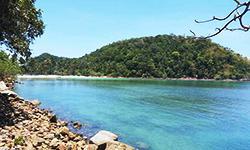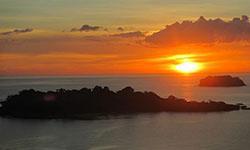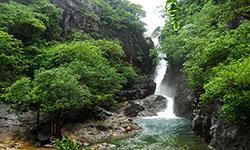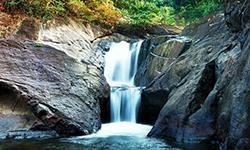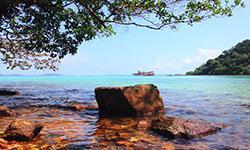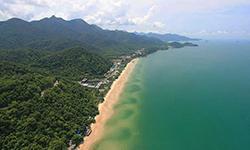Mu Ko Chang National Park
Contact Location : Mu Ko Chang National Park 23/7 Moo 3, Ko Chang Sub-district, Ko Chang Minor District, Trat Province 23170
Telephone Number : (+66) 3 951 0928, (+66) 8 2625 0300 Fax: (+66) 3 951 0928
Email : kochang.dnp@gmail.com
Facebook : Mu Ko Chang National Park
Information
Mu Ko Chang is a National Park that consists of more than 40 large and small islands and islets, including rocky islands in the middle of the sea. Ko Chang is the largest and most famous island of Trat, located in Ko Chang and Ko Kut Minor Districts, Trat Province. Numerous islands, such as Ko Ngam, feature stunning scenery, white sandy beaches, and crystal-clear waters. Some islands have intact coral reefs, such as Ko Wai and Mu Ko Rang.
Background
In 1967, Mr. Somsak Puenduang of Trat province conducted a survey and submitted a preliminary survey report on Than Mayom Waterfall, located in Ko Chang, Laem Ngop District, Trat Province, to the Royal Forest Department to consider establishing the area as a forest park. In 1973, the Royal Forest Department approved in principle the establishment of “Namtok Than Mayom Forest Park,” and the Royal Forest Department issued a letter requesting Trat Province to operate on the establishment of Namtok Than Mayom Forest Park in 1974. Later, in 1975, Trat Province gave Mr. Thanong Hotapawanon, a forestry officer, permission to establish Namtok Than Mayom Forest Park.
Later, the National Park Board resolved in a meeting No.2/1981 on July 28, 1981, to proceed the establishment of the Ko Chang and Ko Kut areas in Trat Province as another marine national park. Therefore, the Royal Forest Department ordered Mr. Ruangsilp Prakonsri, a Forestry Technical Officer Level 4, to conduct a detailed survey as well as to improve the conditions of Namtok Than Mayom Forest Park in order to upgrade its status to a national park. According to the survey data of Namtok Than Mayom Forest Park, Ko Chang and its neighboring islands feature stunning scenery, waterfalls, and a diverse array of wildlife. Moreover, during the Indochina war period, an important event occurred in the eastern coast of Ko Chang, that is His Thai Majesty's ships of Songkhla, Chonburi, and Thonburi bravely battled with seven French warships on January 17, 1941. This valiant act has been immortalized in the Thai navy's history.
To preserve the oceanic islands' history and natural environment, the National Park Division, Royal Forest Department presented to the National Park Board which later resolved in the meeting No.1/1982 on June 15, 1982 that Ko Chang should be established as a National Park. Accordingly, there is a royal decree specifying the land areas of Ko Chang and nearby islands in Ko Chang and Ko Mak Sub-district , Laem Ngop District, Trat Province, covering an area of 406,250 rai, or 650 square kilometers. The water surface in which it is about is about 458 square kilometers of water, or 70 percent of the total area, as a National Park. Therefore, the announcement was made in the Government Gazette, Volume 99, Section 197, dated December 31, 1982, and it is the 45th national park in Thailand.
Note : After paying the entrance fee to the National Park, please carry the receipt for inspection.
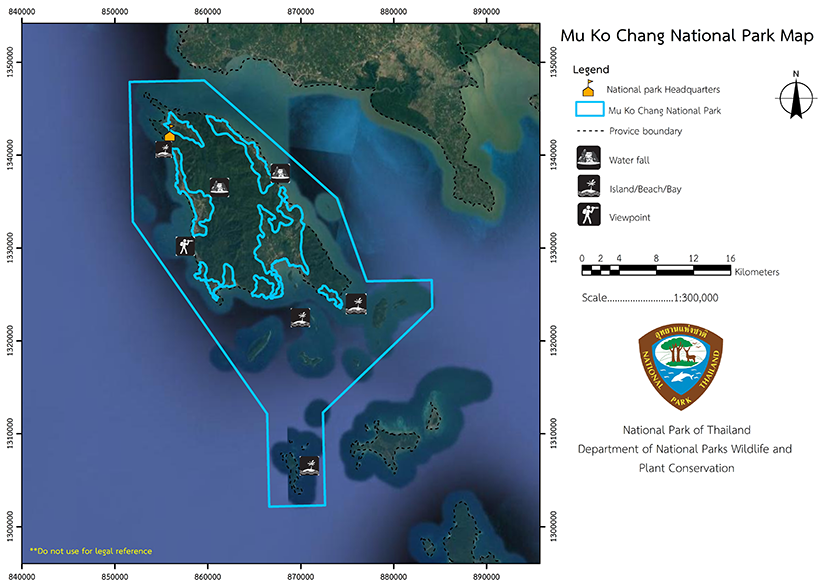
406,250 rai (650 square kilometers).
|
Ko Ngam |
Ko Lao Ya |
||
|
Kai Bae Viewpoint |
Khlong Plu Waterfall |
||
|
Than Mayom Waterfall |
Mu Ko Rang |
||
|
Sai Khao Beach |
|||
Nature trails ⇔ Visit Waterfall ⇔ Snorkeling ⇔ Scuba diving
Welfare shop : (coffee, drinks, snacks) is open daily from 8:00 - 17:30 hrs.
Mobile phone signal :
1. Than Mayom Waterfall area: AIS, TRUE, DTAC
2. Khlong Phlu Waterfall area: AIS, TRUE, DTAC
3. Kai Bae viewpoint area: AIS, TRUE, DTAC
4. Mu Ko Rang area: AIS, TRUE, DTAC
|
|
Ko Chang is the largest island among 40 islands in Mu Ko Chang National Park, about 8 kilometers from Laem Ngop. The area from the north to the southeast is about 30 kilometers long and about 14 kilometers wide. Ko Chang is the third largest island in Thailand after Ko Phuket and Ko Samui. The National Park area does not cover all areas of Ko Chang. There are some parts of Ko Chang Minor District where people live in. Mu Ko Chang National Park terrestrial terrains are primarily covered by mountains, including Khao Lan, Khao Chom Prasat, Khao Khlong Mayom, and Khao Salak Phet, the highest peak is Khao Yai peakat approximately 743 meters above sea level. The majority of the geological structures in the area are igneous rocks of the Triassic period, dating from 195 to 230 million years ago. There are coastal plains in Mu Ban Salak Phet, Mu Ban Salak Khok, Mu Ban Khlong Son, and Ao Khlong Prao. The kind of watercourse found in Ko Chang are short canals that seawater can reach. The headwaters are freshwater streams flowing down from the mountains waterfall and flowing through the mangrove swamp forests before entering the sea. The crucial canals are Khlong Son, Khlong Mayom, Khlong Khang, Khlong Bang Bao, Khlong Prao, and Khlong Nonsi. Additionally, these streams are the origin of many beautiful waterfalls, such as the Than Mayom Waterfalll, Khlong Phlu Waterfall, Khlong Nonsi Waterfalll, Khiri Phet Waterfall, and Khlong Nueng Waterfall. Additionally, there are mudflats and a narrow rocky beach along the east coast of the island, while the sandy and rocky beaches are on the western side. |
|
Rainy season starts from May to October every year. The period is influenced by the southwest monsoon, with an average annual rainfall of about 4,700 mm. Winter starts from November to February when the northeast monsoon prevails over the area, causing the temperature to drop. Summer starts from March to April. The sun is moving across the equator to the northern hemisphere during this time period. The northeast monsoon is weak and quite variable. There is little rainfall that makes the weather hot, especially in April. The average annual temperature is around 27 degrees Celsius.
|
|
|
|
|
Flora and wildlife Mu Ko Chang National Park has a great diversity of plants. The forests are mostly composed of evergreen species and relatively distant from the coast. The predominant plants are the family Melastomataceae, Anneslea fragrans Wall, and plants in the family Myrtaceae that grow sporadically. The important plant species are Dipterocarpus alatus, Anisoptera costata, Iron Wood, Schima wallichii, Podocarpus neriifolius, Croton oblongifolius Roxb, Oncosperma tigillaria (Jack) Ridl, Wart Fishtail Palm, Rattan, Freycinetia angustifolia, Orchids, Bamboo, Bustard Cardamom, Best Cardamom. There are plains along the coast in Mu Ban Salak Phet, Mu Ban Salak Khok, Mu Ban Khlong Son, and Ao Khlong Prao. The beach forest is a sparse forest with few plants, such as Tropical Almond, Alexandrian laurel, Antidesma puncticulatum Miq, Cajuput tree, and Seashore Screwpine. Mangrove swamp forests spread along the muddy shores around the bay areas and estuaries of the various streams. The important plants are Loop-root Mangroves, Rhizophora apiculata, Ceriops decandra, Aegiceras cornicalatum, Black Mangrove, Black Gram, Avicennia marina, Cedar Mangroves, Sea Hibiscus, and Pong-Pong trees (Cerbera odollam Gaertn). In addition, there are swamp forests which are plant communities found in areas with year-round waterlogging in the areas of Ao Salak Khok and Ao Salak Phet. Plants found include Sea Holly and Umbrella Plant. Mu Ko Chang has no sediment deposition from the rivers, so these islands have white sandy beaches with beautiful clear waters and rich marine life, especially coral reef organisms such as Massive Corals, Staghorn Corals, Submassive Corals, Tabulate Corals, Giant Clams, Anemones, and beautiful Coral Fish, Sea Fans, and Algae. These marine organisms can be found in the areas of Ko Chang Noi, the northeastern part of Ko Chang, Ko Yak, Ko Man Nok, Ko Klum, Ko Wai, Ko Lao Ya, Ko Ngam, Ko Rang, Ko Kra, and the area with the wrecks of His Thai Majesty's Ship Chonburi (HTMS Chonburi), and the His Thai Majesty's Ship Songkhla (HTMS Songkhla) near Ao Salak Phet. A survey of wildlife populations in 1992 found that Mu Ko Chang National Park has mammals of 29 species, including Wild Boar, Barking Deer, Stump-tailed Macaque, Indochinese Silvered Langur, Indian Small Civet, Javan Mongoose, Bats, Squirrels, and Rodents, and 74 species of birds, of which 61 species are permanently resident in Thailand and non-migratory, such as Pacific Reef Egret, Yellow-vented Bulbul, Large-tailed Nightjar, Pacific Swallow, White-breasted aterhen, and Oriental Pied Hornbill. During the winter, eight species of winter visitors to Thailand include the Green Heron, Greater Sand Plover, White-winged Black Tern, Knot Bird, Black-naped Oriole, Pale-legged Leaf Warbler, Arctic Leaf Warbler, and Barn swallow, two species of which are migratory birds for breeding, namely the Hooded Pitta and the Blue-winged Pitta. Three bird species migrate to Thailand in other seasons, consisting of Zappey's Flycatcher, Blue-throated Blue Flycatcher, and Eastern Crowned Warbler. There are also 42 amphibians and reptiles, including Mud Turtles, Monitor Lizard, Python, Reticulated Pythons, Ptyas, King Cobra, and Ko Chang Frog (this frog is an endemic species in the tropical rain forest |
How to get there by car :
Take Bangna-Trat road (Highway No. 3), a distance of 312 kilometers to the town of Trat, and then continue to Laem Ngop Pier, about 17 kilometers away. Then take a ferry from one of ferry piers, which are located in many ports, including Center Point Pier, Ferry Pier, Than Mayom Pier at Ao Thammachat, Dan Kao Pier, and Ao Sapparot Pier. Passenger ferries depart every hour. It is approximately a 40-minute journey. Then proceed to the desired location.
- National Park Ranger Station Ko Cho No. 1 (Than Mayom)
- National Park Ranger Station Ko Cho No. 2 (Khlong Son)
- National Park Ranger Station Ko Cho No. 3 (Salak Phet)
- National Park Ranger Station Ko Cho No. 4 (Khlong Plu)
- National Park Ranger Station Ko Cho No. 5 (Ko Rang)
- National Park Ranger Station Ko Cho No. 6 (Bang Bao)
-

